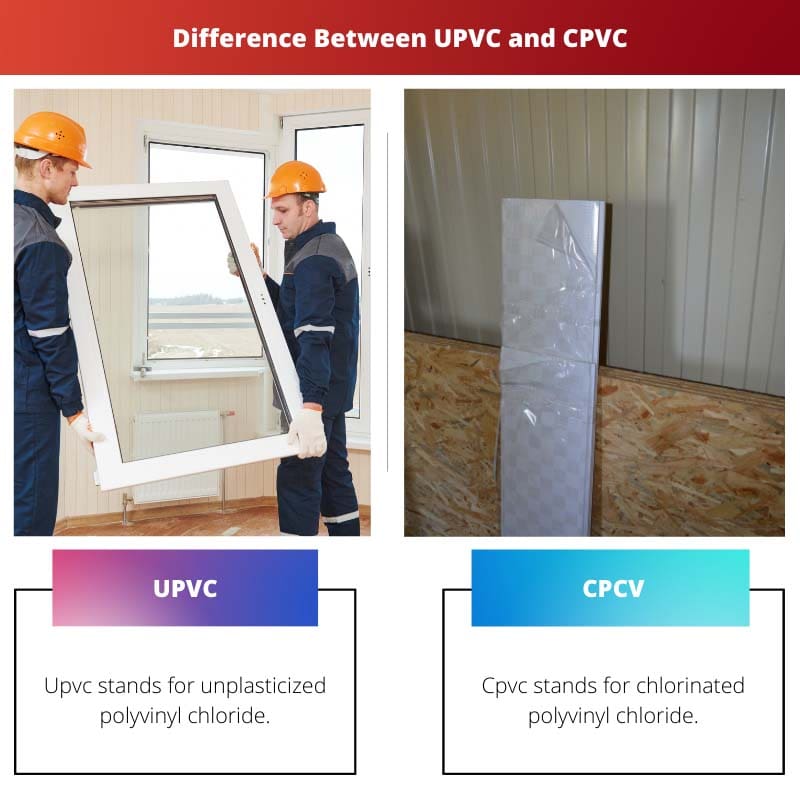Pvc, also known as polyvinyl chloride or polychloroethene, is a thermoplastic. It softens up when heated and hardens up when cooled. Pvc is made by polymerization of the monomer vinyl chloride CH2=CHCl.
The more plasticizers are added, the more pvc turns softer. It is the most common plastic type used for domestic and industrial products. Pvc can further be classified under upvc and cpvc.
Key Takeaways
- uPVC (unplasticized polyvinyl chloride) and CPVC (chlorinated polyvinyl chloride) are plastic pipes used for plumbing and construction.
- uPVC pipes are rigid, durable, and more resistant to chemicals and UV rays; CPVC pipes are more flexible and heat-resistant, making them suitable for hot water systems.
- uPVC pipes are used for cold water systems, drainage, and sewage applications; CPVC pipes are used for hot and cold water systems and chemical transport.
UPVC vs. CPVC
UPVC is a rigid and strong material resistant to corrosion, chemicals, and UV radiation, making it a popular choice for water supply and drainage systems and construction. CPVC is more flexible and heat-resistant than uPVC, used for hot water supply systems, industrial piping, and fire sprinkler systems.

Upvc is also known as unplasticized polyvinyl chloride. It is a solid and very versatile material. It is highly resistant to moisture, the atmosphere, and certain chemicals. Upvc is used in window sills and frames.
It is a great substitute for timber wood and aluminum. It is quite easy and simple to install.
Cpvc is known as Chlorinated polyvinyl chloride. It is a thermoplastic made by the process of chlorinating polyvinyl chloride resin. It is highly resistant to degradation, chemicals, majorly acids, alkalis, and salt hence it is best suited for the chemical industry.
Comparison Table
| Parameter of Comparison | Upvc | Cpvc |
|---|---|---|
| Stands for | Unplasticized polyvinyl chloride | Chlorinated polyvinyl chloride |
| Plasticization | Not composed of any plasticizers | It is composed of plasticizers |
| Malleability | It is not bendable | It is bendable |
| Temperature Resistance | It cannot be used to carry high-temperature liquids | It can be used for carrying high-temperature liquids |
| Rigid | It is highly rigid | It is flexible |
| Water | It should not be used for drinking water transmission | It is safe for transportation of drinking water |
What is Upvc?
UPVC stands for unplasticized polyvinyl chloride. It is used as a low-maintenance building material instead of painted wood, mainly used for installing window frames and sills.
It is a versatile material that is highly resistant to several chemicals.
Unplasticized polyvinyl chloride pipes are less bendable and are a little difficult to work with as they are sturdy. It can also be used in heavy-duty plumbing.
Upvc is a transparent and hard-wearing or rigid material. It is resistant to moisture and chemicals; hence they have excellent electrical properties and low inflammability.
Upvc is a much more reasonable alternative to expensive hardwood timber and aluminum. The material is highly resistant to corrosion.
Upvc is suitable for the transportation of processed water wastewater and a large number of chemicals. It can also be used with various ranges of pressure on the material. They are fire-resistant and can also be recycled and reshaped.
What is Cpvc?
Cpvc stands for chlorinated polyvinyl chloride. It is a thermoplastic polymer. The chemical formulation of cpvc is C9H11Cl7.
The process makes it of chlorinating the polyvinyl chloride resin. The chlorination process helps achieve more flexibility and strength to withstand high temperatures.
The application of thermal or UV energy mostly initiates the reaction. In this process, chlorine gas decomposes into free radical chlorine and reacts with PVC in the post-production stage.
This results in replacing hydrogen in PVC with chlorine to form cpvc.
Cpvc is high in chlorine content. It has excellent resistance to chemicals and majorly acids, alkalis, and salts; hence it is a very appropriate material in the chemical industry. The temperature range of application varies from-40oC to +95oC.
Chlorinated polyvinyl chloride is a highly valuable material. It is a structurally rigid, solid plastic material used in industrial media transport applications. It has a maximum operating temperature of up to 100oC.
Cpvc is characterized as easy handling as a simple and fast bonding material. It is also best or transfer both treated and untreated drinking water. Cpvc is also known for its optimum temperature stability and non-flammability quality.
It is lightweight and very easy to transport material. It can be bent, shaped, and welded in any shape and form.
Main Differences Between Upvc and Cpvc
- UPVC stands for unplasticized polyvinyl chloride, whereas cpvc stands for chlorinated polyvinyl chloride.
- Upvc does not contain any plasticizers, whereas cpvc is made of plasticizers.
- Upvc is highly rigid and not malleable. However, cpvc is flexible and bendable.
- Upvc is only suitable for working at a temperature ranging from 0oC to 65oC; hence, it cannot carry high-temperature liquids. However, cpvc is suitable for working between -40oC to +95oC; hence, it is suitable for carrying high-temperature liquids.
- Upvc is unsuitable for water transportation, whereas cpvc is a colorless and odorless material that can be used to transport drinking water.




